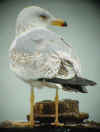L. michahellis: 3cy May
General
description:
By May the numbers of 3cy michahellis slightly increase at Etaples in NW France with a few 10's in total (Etaples,
Dannes, Boulogne-sur-Mer, see the Le
Portel Page). Probably, many 3cy birds frequent the future
breeding sites already and only return at Etaples from late June onwards.
The general appearance of May 3cy michahellis is rather
straightforward. Most birds are easily recognized between 3cy argenteus, with
darker grey upper-parts, pitch black primaries, with a red orbital
ring and of course with yellow legs. An example of the average michahellis can be found in the first image.
Moult
stage and pace of remiges and rectrices:
By mid-May, primary moult is just starting
in 3cy birds, which are about two primaries behind compared to 2cy birds
(with P3 and P4 missing by mid-May). The outer primaries and secondaries are second generation,
replaced about half a year ago, the white crescents are worn away.
The rectrices have the white tips worn way as well. By May, the
partial spring moult has finished, and a small minority of 3cy michahellis have included some rectrices in this moult. Hence, it's not uncommon
to find 3cy birds showing plain white tail-feathers, in some birds
creating a 'blocked' tail pattern.
Timing and
strategy of wing-covert moult in May
What's the average moult in May? We didn't
described enough 3cy birds in detail to draw any conclusions, the sample
size has been too small. A few preliminary conclusions:
Head-streaking, which was
obvious during the winter months and concentrated on the ear-coverts, around the eye and up to the
crown from September to March, has been replaced by snow-white fresh head-feathers.
The head and under-parts are white by May.
3cy birds show a combination of adult-like
grey scapulars, contrasting with adjacent barred lesser coverts. By May,
moult in the scapulars is near zero in 3cy michahellis. In some
individuals, the scapular region contains some old and abraded feathers,
sometimes showing a barred pattern, others are completely bleached white
with only a slightly darker shaft-streak. However, most birds have the
entire back adult-like grey.
In several sections of 1cy
and 2cy michahellis it's mentioned that birds include wing-coverts
in the post-juvenile moult (unlike argentatus / argenteus where this post-juvenile moult is confined to the scapulars). Wing-coverts
are replaced again in the compelte moult in 2cy and inner wing-coverts are
included in the partial moult in autumn in 2cy. In 3cy
birds, the wing-coverts are predominantly second generation, especially
the outer greater coverts and most of the lesser coverts (in the carpal edge).
Especially the median and lower lesser tract contain a mix of third or even fourth generation
wing-coverts.
The upper tertials are often included in the post-juvenile moult and the
partial autumn moult of 2cy as well. Some of the tertials, like the inner median and inner lower
lesser coverts, may appear adult-like, sometimes plain grey. However,
these grey third and fourth generation tertials may still show a delicate
diffuse brown pattern.
As stated earlier, the complete moult
starts by mid-May, with 3cy birds dropping the innermost primary P1.
Subsequently, the outer median coverts are shed as well as a start of the
complete moult in the wing-coverts. This is the moult stage by the end of
the month.
See Topography
Section for explanation of feather tracts.
Movements
By May, only the number of 3cy michahellis along the coasts of NW France increases slightly, as 3cy michahellis probably prefer this area to undergo the complete moult. At Etaples'
fish-market, there is plenty of food. They probably belong
to michahellis from the colonies of Marseille and the
Mediterranean coast.
Tables
No tables.
|
 AE4F8374 Tel Aviv University Zoological Garden 24.5.11.jpg) michahellis 3cy male, May 24 2011, Tel Aviv - University Garden, Israel. Picture: Amir Ben Dov. Breeding. michahellis 3cy male, May 24 2011, Tel Aviv - University Garden, Israel. Picture: Amir Ben Dov. Breeding.
|
 Yellow-legged
Gull - Larus michahellis
Yellow-legged
Gull - Larus michahellis AE4F8374 Tel Aviv University Zoological Garden 24.5.11.jpg)



